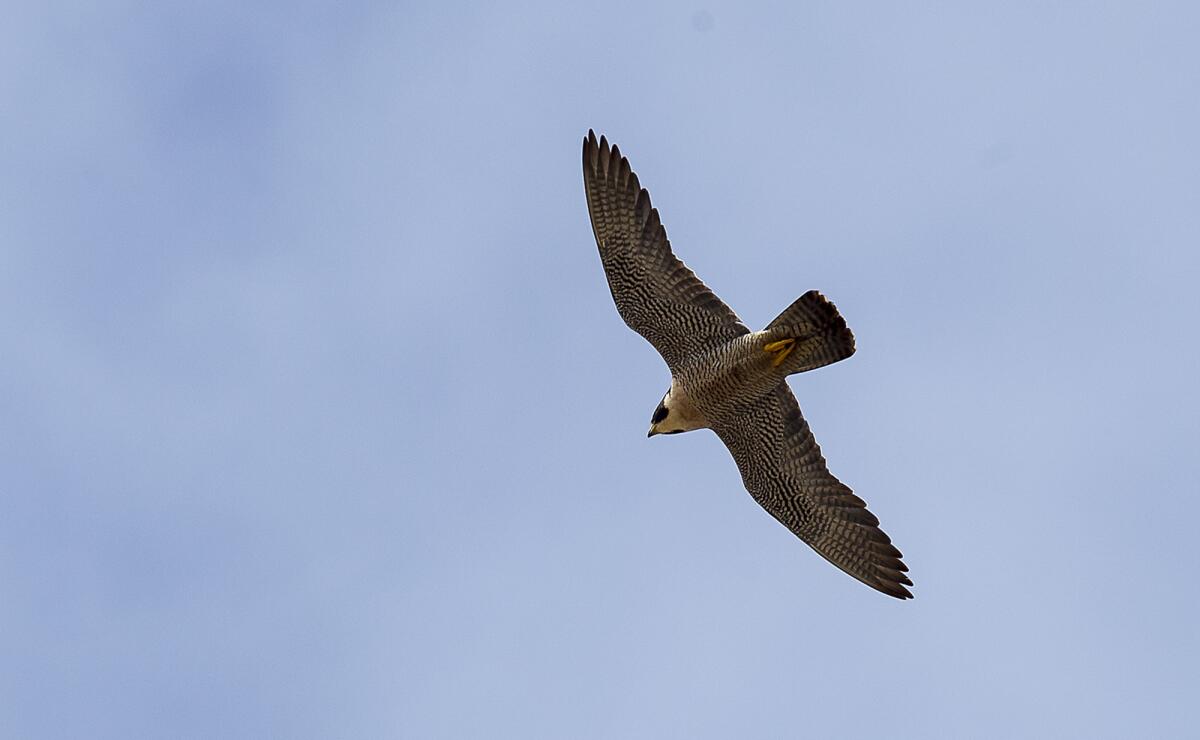Fledgling falcons that fell from Newport office tower get fresh chances to fly

On top of an 18-story building, Hector Armenta held a 7-week-old peregrine falcon.
“My heart was beating just as fast as the baby bird’s was,” he said a few days later.
It wasn’t the height from atop the Newport Beach office tower that made him nervous, Armenta said.
“I was holding the fastest bird alive,” he said, referring to the species’ ability to travel more than 200 mph when diving for prey.
Armenta also wanted to be sure not to hurt the falcon while an expert from the U.S. Fish and Wildlife Service put an identification tag on it and placed it back in a makeshift nest where it squawked loudly enough — the rescuers hoped — to alert its mother.
Armenta, an Irvine Co. engineer, was holding the bird Tuesday because someone had scooped it up from the sidewalk below a few days earlier.
Someone — Irvine Co. officials aren’t sure who — found a fledgling falcon on the sidewalk on June 5 outside one of the company’s buildings at 610 Newport Center Drive.
The bird, unable to fly quite yet, had survived a fluttering fall from a nest on the roof, but it was trapped on the ground.
Irvine Co. employees called animal control to take the bird, but over the weekend, four more fledglings made their way down to the street.
There was a fifth bird, but Irvine Co. employees don’t know what happened to it.
Animal control took the four remaining falcons to the Wetlands & Wildlife Care Center in Huntington Beach, but because the facility isn’t intended for birds of prey, the center called Scott Thomas, a volunteer raptor rescuer from Mission Viejo who has spent years studying the birds.
*
Out of their element
In nature, Thomas said, peregrines nest on cliffs or trees. This makes for a gentler learning curve when the fledglings start to fly because they can land on lower branches or perches as they flutter around.
But on the smooth glass sides of an office building, there’s nowhere for the birds to regain their composure, and they end up sliding to the ground, he said.
Armenta and Irvine Co. Chief Portfolio Engineer Tony Furnari said it’s not uncommon to see peregrines around Newport Center. Nearby wetlands and golf courses provide hunting grounds, and the office complex’s tall buildings give them safety to perch.
“Nobody can reach them,” Armenta said.
Thomas estimated that a half-dozen pair of peregrines nest on buildings throughout Orange County and that two or three more pairs nest on trees or cliffs.
The number climbed during the past few decades as the species recovered from near extinction. According to the Fish and Wildlife Service, there were only 324 known breeding pairs of the falcons in 1975, but the number is now 2,000 to 3,000.
*
Another try to fly
Thomas took the birds to the Orange County Bird of Prey Center in Laguna Hills to make sure they were healthy, but he ultimately wanted to reunite them with their mother.
“They don’t do well at that age in a rehabilitation center,” he said.
So he contacted Joel Pagel, a biologist friend at the U.S. Fish and Wildlife Service.
On Tuesday, with the help of Armenta and Furnari, Pagel carried the birds in a large dog crate back to the roof from which they had fallen.
That apparently worked for three of the birds, which their rescuers believe flew away into the wild. But on Tuesday night, the only female in the group was back on the ground, perched on a trash can.
Furnari had security guards monitor the bird throughout the night through the office complex’s security cameras.
“She didn’t fly, but she was in good shape,” he said.
Around 6 a.m. Wednesday, he got a call that the bird looked agitated at workers who had begun to arrive. The falcon tried to take off and ended up in bushes at Fashion Island across the street, Furnari said.
Again, rescuers took her back to the roof.
Armenta and Furnari kept an eye on her, watching from the ground and peeking from the rooftop stairs when they had a chance.
By Thursday morning, she was gone, apparently finally taking flight. On the roof, Armenta and Furnari scanned the cloudy skies for any sign of her or her siblings.
Furnari pointed to some meat scraps that he considered evidence that the family must be doing well enough to hunt.
“You can see the remains of the food sitting right there on the ledge,” he said.
Not long after, a single falcon soared over the roof, close enough to glimpse the brown-and-white pattern on its underside. It was the mother, the men concluded.